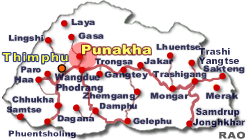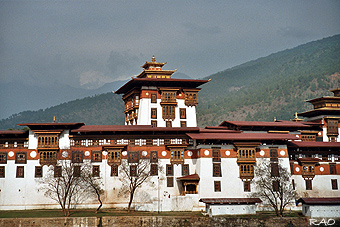 |
Bhutan's Culture - Dzongs |
|
 |
Bhutan Information |
|
|
 |
 |
|
Punakha
Dzong's time line
|
The
construction of the Punakha Dzong greatly contributed to the revival of
the 13 traditional arts of the zorig chusum. Artisans from all parts of
the country were called on to hone their skills and a new generation of
Bhutanese craftsmen was trained in the traditional skills and arts of the
zorig chusum, under the supervision of the best craftsmen in the country. |
Among
the most important sections of the dzong that were completely reconstructed
were the Machen Lhakhang where the sacred relics of Zhabdrung Ngawang
Namgyal rest in thudam (permanent retreat), the Kuenrey (congregation
hall), the Tsen Chhorten which houses the eight sandalwood chhortens, the Je
Zimchung, and monks' living areas. Major restoration work was done
on the Utse (central tower), the Kuenreys of the Drabi and Tshennyi
divisions of the central monk body. The entire environment around the
dzong was given a facelift and the banks of the rivers secured against
major floods in future.
The
three-storey Machen Lhakhang was built out of cyprus wood with four
entrance pillars intricately embossed with religious symbols in gold and
silver. The inside of the lhakhang has been decorated with intrinsic and
rich murals and frescos depicting the teachings of Lord Buddha. The images
of seven incarnations of the Zhabdrung were also installed in the
lhakhang. An ornate 15-foot Kudung Chhorten was installed, made
of sandalwood and encased in silver and gold and adorned with jewels like
corals, pearls, turquoise, and other precious stones. It was constructed
by 20 craftsmen over four years.
The
Kuenrey, which was on the verge of collapse, was reconstructed on a
grand scale. This great hall now features 12 30-foot cyprus pillars adorned
in gilded brass plates embossed with elaborate religious sculpture. In
the Kuenrey sits the main 35-foot image of Buddha Shakyamuni, crafted out
of a mixture of five menjim (precious substances) and medicinal clay. The
back wall carries images of the 16 arhats. The Buddha is flanked, on the
right, by a 28-foot image of Guru Padmasambhava and, on his left,
by a 28-foot image of Zhabdrung Ngawang Namgyal. Along the left wall of
the Kuenrey sit 48 three-foot images of the spiritual masters of the kagyu
lineage. On the right side are 48 three-foot images of dongyu zinpa (lineage
holders).
|
Punakha
Dzong
Time
and natural elements as well as human weaknesses had thus taken their toll
on this proud edifice. By the late 1980s many lhakhangs were on the verge
of collapse because the wooden structures of the dzong had decayed. Precious
images and manuscripts had been damaged and destroyed with losses estimated
at millions of Ngultrums.
It
was then that His Majesty the King commanded the reconstruction of the
dzong.
|
 |
Under His Majesty's personal supervision, Bhutan's centuries-old
building and artistic traditions came together and, over the past 12 years, thousands
of carpenters and wood sculptors, metal and clay sculptors, masons, painters,
fresco experts, electricians, blacksmiths, goldsmiths, silversmiths, tailors,
and monk artisans re-lived history as they worked on the Punakha Dzong
Renovation Project.
| Information on Bhutan |
 |
|



